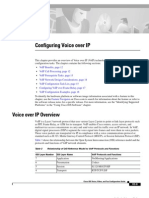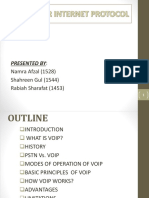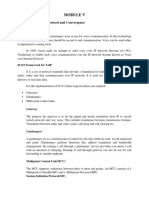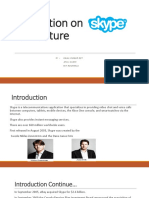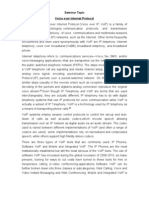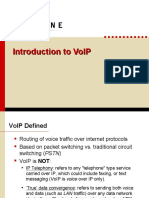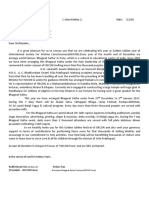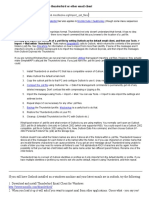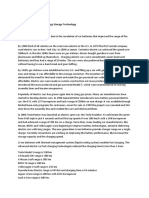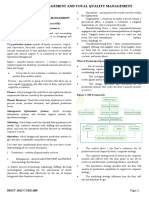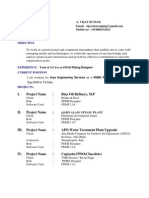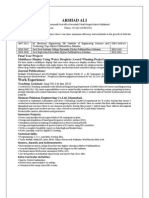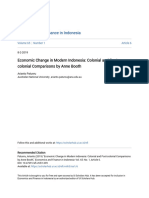Vox 800 Toll Free
Vox 800 Toll Free
Uploaded by
Nilesh JadhavCopyright:
Available Formats
Vox 800 Toll Free
Vox 800 Toll Free
Uploaded by
Nilesh JadhavOriginal Description:
Copyright
Available Formats
Share this document
Did you find this document useful?
Is this content inappropriate?
Copyright:
Available Formats
Vox 800 Toll Free
Vox 800 Toll Free
Uploaded by
Nilesh JadhavCopyright:
Available Formats
Vox800
Service
Overview via the public Internet or via a private interconnection with Voxbones core
network in the SuperPOP closest to the customers network infrastructure.
With Vox800, Voxbone provides local toll-free phone numbers from To ensure quality of service for call delivery via the public Internet, Voxbone
various countries for direct inward dialing (DID). Calls to these telephone is directly interconnected with 12 Tier-1 global Internet carriers.
numbers are converted from PSTN to VoIP and are transported to
anywhere in the world over Voxbones intercontinental private IP
backbone. In a growing number of countries, existing telephone numbers Service Applications
can be ported to the Vox800 service.
Vox800 is used for business applications that require inbound calling.
Calling toll-free numbers is free for the caller. Consequently, a per- Typical applications include:
minute fee is charged to the Vox800 customer. The per-minute fee
varies among countries depending on the type of network from which Virtual local telephone numbers for international businesses
the call originated. Wherever possible, Voxbone offers its customers the International access numbers for:
possibility to block calls per type of originating network, a feature known Teleconferencing services
as Calling Party Category (CPC). Voice applications and IVRs
Call centers
Calling-card service providers
How it Works
Voxbone operates as a licensed telecommunications service provider in 55+ Technical Specifications
countries. In the majority of these countries, Voxbone has its own telephone
number ranges and local network infrastructure and has porting agreements Protocol SIP
with local operators and national regulators. In other countries, Voxbone has
long- term leasing agreements with local Tier-1 carriers. Codecs G711a, G711, G729
CLI E.164 CLI, localized CLI
As illustrated in the following diagram, calls to these numbers originate from
DTMF RFC 2883, SIP info
fixed, mobile and payphone telephone networks and are then converted to
VoIP (SIP) by a VoIP/media gateway. The call is then routed via redundant IP CPC IETF draft-mahy-iptel-cpc-06
links to the nearest SuperPOP in Brussels, New York, Los Angeles, Frankfurt
Failover DNS-SRV, backup URI
or Hong Kong. From there, it can be transported to anywhere in the world
Load balancing DNS-SRV
Security TLS
Other supported RFC 3323 (Privacy mechanisms for SIP), RFC 5806
specifications (Diversion indication in SIP)
You might also like
- Marketing Communications Touchpoints, Sharing and Disruption, 8th Edition (Great For Case Studies)Document804 pagesMarketing Communications Touchpoints, Sharing and Disruption, 8th Edition (Great For Case Studies)Linh LinhNo ratings yet
- Blockchain Unconfirmed Transaction Hack ScriptDocument4 pagesBlockchain Unconfirmed Transaction Hack ScriptPrecious Clement67% (3)
- Caterpillar Serial Number ModelDocument48 pagesCaterpillar Serial Number ModelLody79% (14)
- PDIC ReviewerDocument9 pagesPDIC ReviewerAlbeth HanasanNo ratings yet
- Voice Over IPDocument22 pagesVoice Over IPTrace JackNo ratings yet
- Basic Electronic ComponentsDocument23 pagesBasic Electronic ComponentsNilesh Jadhav100% (5)
- Artificial Intelligence in Telecom - Industry Adoption AnalysisDocument88 pagesArtificial Intelligence in Telecom - Industry Adoption AnalysisJas Bararia100% (1)
- Voice Over Internet ProtocolDocument17 pagesVoice Over Internet Protocolguru0416100% (4)
- Architectural Differences SIP and MGCPDocument8 pagesArchitectural Differences SIP and MGCPcdhakaNo ratings yet
- Arshin's Mini ProjectDocument37 pagesArshin's Mini Projectayankhan1516No ratings yet
- Security and ImplementationDocument2 pagesSecurity and ImplementationJuscal KwrldNo ratings yet
- Voip and Its Security: AbstractDocument7 pagesVoip and Its Security: AbstractMunendraNo ratings yet
- Understanding Roip NetworksDocument13 pagesUnderstanding Roip NetworksPRAMMASANIHEMANTHNo ratings yet
- Final Year Project ReportDocument48 pagesFinal Year Project ReportRumman Arshad DarNo ratings yet
- Options in Voice Communication: by H Raghavan CCCF 7 Aug 2015Document33 pagesOptions in Voice Communication: by H Raghavan CCCF 7 Aug 2015Treblig SairaNo ratings yet
- Voice Over Internet Protocol PDFDocument20 pagesVoice Over Internet Protocol PDFKurama 9TalesNo ratings yet
- Voice Over Internet Protocol (VoIP) - A ReviewDocument4 pagesVoice Over Internet Protocol (VoIP) - A ReviewInternational Journal of Innovative Science and Research TechnologyNo ratings yet
- Voice Over IP OverviewDocument24 pagesVoice Over IP OverviewQuang LeNo ratings yet
- A Quick Introduction To Voice Over Internet Protocol (Voip)Document4 pagesA Quick Introduction To Voice Over Internet Protocol (Voip)Usman Ahmed MazharNo ratings yet
- VoipDocument25 pagesVoipnehank17No ratings yet
- Ip PBX: Future University Telecom Department Telecommunication System III AssignmentDocument10 pagesIp PBX: Future University Telecom Department Telecommunication System III AssignmentBakry MatterNo ratings yet
- (Voice Over IP) : Yonca Cumurcu Koray KurtDocument44 pages(Voice Over IP) : Yonca Cumurcu Koray KurtKevin MlayNo ratings yet
- Voip, Msan and NGNDocument30 pagesVoip, Msan and NGNReynald John PastranaNo ratings yet
- IP Telephony 2Document2 pagesIP Telephony 2neylaxNo ratings yet
- Chapter 6 Voice Over IPDocument26 pagesChapter 6 Voice Over IPShame BopeNo ratings yet
- Voice Over Internet ProtocolDocument23 pagesVoice Over Internet Protocolkarthiksrinivas100% (3)
- E Business Chapter 6Document30 pagesE Business Chapter 6Jakia ChyNo ratings yet
- Presented By:: Namra Afzal (1528) Shahreen Gul (1544) Rabiah Sharafat (1453)Document40 pagesPresented By:: Namra Afzal (1528) Shahreen Gul (1544) Rabiah Sharafat (1453)Irakli JorjadzeNo ratings yet
- Voice Over Internet ProtocolDocument41 pagesVoice Over Internet ProtocolSahir LodhiNo ratings yet
- Voice Over Internet Protocol (Voip) : A Seminar Report OnDocument20 pagesVoice Over Internet Protocol (Voip) : A Seminar Report Onkummari suhithNo ratings yet
- Mohammed Nawfal Al-Damluji: Prepared byDocument22 pagesMohammed Nawfal Al-Damluji: Prepared byMuhammed DamlujiNo ratings yet
- Voice Over Internet Protocol and Convergence Voice Over Ip: H.323 Framework For VoipDocument4 pagesVoice Over Internet Protocol and Convergence Voice Over Ip: H.323 Framework For VoipAswanthNo ratings yet
- sl4020 DatasheetDocument2 pagessl4020 DatasheetMatija ProtrkaNo ratings yet
- 07-It Seminar Dhans VoipDocument11 pages07-It Seminar Dhans VoipAnnonymous963258No ratings yet
- Presentation On Architecture: Kajal Kumar Dey Atul Silori Nit RourkelaDocument19 pagesPresentation On Architecture: Kajal Kumar Dey Atul Silori Nit Rourkelakajal kumar deyNo ratings yet
- Voice Over IPDocument32 pagesVoice Over IPPrakash RanjanNo ratings yet
- Roll. (2) Huma MukhtarDocument28 pagesRoll. (2) Huma MukhtarHasnin shahNo ratings yet
- (Voice Over Internet Protocol) : Department of Electronics & Communication Govt Engineering College ThrissurDocument44 pages(Voice Over Internet Protocol) : Department of Electronics & Communication Govt Engineering College Thrissuryuben josephNo ratings yet
- All About VoIPDocument102 pagesAll About VoIPlegharimehjabeenNo ratings yet
- (Introducing Voice Over Ip Networks) : Voip FundamentalsDocument8 pages(Introducing Voice Over Ip Networks) : Voip FundamentalsRodmar Ferol MaligayaNo ratings yet
- IP Phone Communication Over WiFiDocument14 pagesIP Phone Communication Over WiFiKakani SanthiNo ratings yet
- Multivoip: Gateways Have Been DiscontinuedDocument4 pagesMultivoip: Gateways Have Been DiscontinuedCarlos Rumay DilasNo ratings yet
- Voice Over Internet Protocol (Voip) : Presentation By, V.Nithya M.Tech - IT (Final Year) 1631010033Document41 pagesVoice Over Internet Protocol (Voip) : Presentation By, V.Nithya M.Tech - IT (Final Year) 1631010033Nithya5189No ratings yet
- SN4110 DatasheetDocument2 pagesSN4110 DatasheetMatija ProtrkaNo ratings yet
- Final Term PaperDocument21 pagesFinal Term PaperKetsia MukalayNo ratings yet
- CP Ipcc Plus Ip Contact Center ServicesDocument8 pagesCP Ipcc Plus Ip Contact Center ServicesVilasak ItptNo ratings yet
- Zone Technologies Services.fDocument10 pagesZone Technologies Services.fnayrouzabshNo ratings yet
- Voip Technology: Presented byDocument13 pagesVoip Technology: Presented byShrikant ModiNo ratings yet
- Omni Ipr-BrochureDocument6 pagesOmni Ipr-BrochureCesar Javier Porras MendiondoNo ratings yet
- VoipDocument2 pagesVoipAnjna SharmaNo ratings yet
- Voice Over Internet ProtocolDocument22 pagesVoice Over Internet ProtocolRicha BudhirajaNo ratings yet
- Voip LecDocument26 pagesVoip LecravinderslathwalNo ratings yet
- Convergence of Voice, Video, and DataDocument40 pagesConvergence of Voice, Video, and DataFrancisco Gonzalez PachecoNo ratings yet
- Product Development Course G01 Presented To: Dr. Raafat El FoulyDocument54 pagesProduct Development Course G01 Presented To: Dr. Raafat El FoulyIrfan QalamkarNo ratings yet
- Understanding Voice Over IP Signaling Protocols in Cisco Telephony ImplementationsDocument7 pagesUnderstanding Voice Over IP Signaling Protocols in Cisco Telephony ImplementationsharshdbaNo ratings yet
- Whitepaper Sip For VoipDocument11 pagesWhitepaper Sip For VoipMas SuwarnoNo ratings yet
- Telephony Elective IiDocument13 pagesTelephony Elective IiAlyssa RicafortNo ratings yet
- Intro To VoIPDocument24 pagesIntro To VoIPPunit SundriyalNo ratings yet
- VoIP (072MSI616, 072MSI617, 072MSI618)Document29 pagesVoIP (072MSI616, 072MSI617, 072MSI618)Anonymous 16Gz2mqc100% (1)
- DVG 7022&7044Document2 pagesDVG 7022&7044scribd2629No ratings yet
- Voice Over Internet Protocol Q & ADocument2 pagesVoice Over Internet Protocol Q & AbarrackNo ratings yet
- MRG StepByStep Rev2.6 JAN2021Document54 pagesMRG StepByStep Rev2.6 JAN2021Edmar AberinNo ratings yet
- Cisco Network Administration Interview Questions: CISCO CCNA Certification ReviewFrom EverandCisco Network Administration Interview Questions: CISCO CCNA Certification ReviewRating: 4.5 out of 5 stars4.5/5 (6)
- Shree Sanatan Trust Upleta Laxmi Narayan Temple ProjectDocument28 pagesShree Sanatan Trust Upleta Laxmi Narayan Temple ProjectNilesh Jadhav100% (1)
- TOI Pune MirrorDocument1 pageTOI Pune MirrorNilesh JadhavNo ratings yet
- Digital Marketing Syllabus - DigiQuestDocument5 pagesDigital Marketing Syllabus - DigiQuestNilesh JadhavNo ratings yet
- Rajasthan PVDDocument1 pageRajasthan PVDNilesh JadhavNo ratings yet
- Bhagwat Katha English Radheshyam PRDocument1 pageBhagwat Katha English Radheshyam PRNilesh JadhavNo ratings yet
- How2 Import .PST Files in ThunderbirdDocument2 pagesHow2 Import .PST Files in ThunderbirdNilesh JadhavNo ratings yet
- 1 Jagannath PuriDocument2 pages1 Jagannath PuriNilesh JadhavNo ratings yet
- Bhagwat Katha English Radheshyam PRDocument1 pageBhagwat Katha English Radheshyam PRNilesh JadhavNo ratings yet
- Bhagavatam MahimaDocument16 pagesBhagavatam MahimaNilesh JadhavNo ratings yet
- Japanese 会社案内: Koike Corporate ProfileDocument2 pagesJapanese 会社案内: Koike Corporate ProfileNilesh JadhavNo ratings yet
- FranchiseDocument5 pagesFranchiseNilesh JadhavNo ratings yet
- 094-095 ProjectsDocument2 pages094-095 ProjectsNilesh JadhavNo ratings yet
- Format PDFDocument1 pageFormat PDFNilesh JadhavNo ratings yet
- National Gayatri Mantra Initiative: Line by LineDocument1 pageNational Gayatri Mantra Initiative: Line by LineNilesh JadhavNo ratings yet
- Sr. No Name Contact No. Pun - BBSR Puri - HWH HWH - PunDocument3 pagesSr. No Name Contact No. Pun - BBSR Puri - HWH HWH - PunNilesh JadhavNo ratings yet
- Shri Hari Darshan: Exotic KeralaDocument11 pagesShri Hari Darshan: Exotic KeralaNilesh JadhavNo ratings yet
- Yatra Registration Form: Shri HaridarshanDocument2 pagesYatra Registration Form: Shri HaridarshanNilesh JadhavNo ratings yet
- What Is Dham (Holy Place) ?Document2 pagesWhat Is Dham (Holy Place) ?Nilesh JadhavNo ratings yet
- Media PlayerDocument7 pagesMedia PlayerNilesh JadhavNo ratings yet
- Sr. No. Description Rate: Thanks & RegardsDocument1 pageSr. No. Description Rate: Thanks & RegardsNilesh JadhavNo ratings yet
- Sr. No. Description Rate: Thanks & RegardsDocument1 pageSr. No. Description Rate: Thanks & RegardsNilesh JadhavNo ratings yet
- Panel FV LG-295-300m - 1686x1016x40 - 1000 - enDocument4 pagesPanel FV LG-295-300m - 1686x1016x40 - 1000 - enjhonathanNo ratings yet
- Snap-On 1992-2013: Vehicle Application GuideDocument100 pagesSnap-On 1992-2013: Vehicle Application GuidedcranskiNo ratings yet
- Bond ImmunizationDocument14 pagesBond ImmunizationYasser HassanNo ratings yet
- Hybrid Energy StorageDocument3 pagesHybrid Energy StorageSteve AbonyiNo ratings yet
- First PartDocument18 pagesFirst PartanthonyNo ratings yet
- Centre Wise CPI IW DEC 2023Document1 pageCentre Wise CPI IW DEC 2023Jandu MaharashtraNo ratings yet
- 16Ch D1 Resolution Real-Time Standalone DVRDocument1 page16Ch D1 Resolution Real-Time Standalone DVRAimee chaconNo ratings yet
- MALIBUDocument4 pagesMALIBUhitecNo ratings yet
- Omgt (Reviewer)Document62 pagesOmgt (Reviewer)Grace DupayaNo ratings yet
- J-335 Owner's ManualDocument72 pagesJ-335 Owner's ManualRay van StratenNo ratings yet
- 2 Proposed Health Products (Therapeutic Products) Regulations 2015Document158 pages2 Proposed Health Products (Therapeutic Products) Regulations 2015Jay ChenNo ratings yet
- RegularSize Catalogue 2023Document108 pagesRegularSize Catalogue 2023farhan energi gasindoNo ratings yet
- PDMS Designer PipingDocument4 pagesPDMS Designer PipingAlla VijayNo ratings yet
- 12-Article Text-230-1-10-20220331Document10 pages12-Article Text-230-1-10-20220331halena layNo ratings yet
- Chapter 1-IntroDocument7 pagesChapter 1-IntroJoanna Mae SatairapanNo ratings yet
- White Paper - 2021 Data Engineering SurveyDocument10 pagesWhite Paper - 2021 Data Engineering SurveyLuis MaldonadoNo ratings yet
- Chapter 11-Income Taxation by E. ValenciaDocument10 pagesChapter 11-Income Taxation by E. ValenciaLeonard Cabuyao100% (1)
- Resume ArshadDocument1 pageResume ArshadArshad AliNo ratings yet
- Computer Studies PracticalDocument5 pagesComputer Studies PracticalMutegeki AdrianNo ratings yet
- Economic Change in Modern Indonesia - Colonial and Post-ColonialDocument4 pagesEconomic Change in Modern Indonesia - Colonial and Post-ColonialhelenrenjaniNo ratings yet
- Visualization and Cybersecurity in The Metaverse A SurveyDocument15 pagesVisualization and Cybersecurity in The Metaverse A SurveySummerGirlNo ratings yet
- 2 Glass Block MSDocument6 pages2 Glass Block MSGaneshNo ratings yet
- Erotic CultDocument6 pagesErotic Cultmallikai_1No ratings yet
- CJC K: by G. Mesri, M. ASCE, and A. CastroDocument18 pagesCJC K: by G. Mesri, M. ASCE, and A. CastroRivaiNo ratings yet
- Kasus EnronDocument4 pagesKasus Enronsh573No ratings yet

















